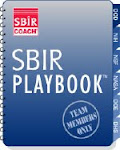In my last Blog posting (on Oct 29th) I talked about things that the DOD is doing to support Phase III commercialization of SBIR-funded technologies. Today it's NASA's turn.
I had lunch today with two very interesting people: Carl Ray, the SBIR Program Manager for NASA, and Darwin Molnar, the VP for SBIR and NASA Tech Transfer for the National Technology Transfer Center (NTTC). We talked about the difficulties that small businesses face when attempting to transition technology being developed under NASA SBIRs to the commercial marketplace, and what's being done to aid that process.
Carl and I have been friends ever since he became NASA's SBIR chief back in the early 90s. NASA has always been focused on funding those SBIR projects that have the greatest likelihood of eventually being deployed into NASA systems. We've disagreed on some of NASA's communication policies, but have always agreed on one thing: Getting an SBIR project to Phase III must be actively supported. Companies need guidance in the culture change in moving out of R&D mode into commercialization, and they need the funding to get there.
NASA first turned to the NTTC for support to effect transferring space program technology to general marketplace utilization back in 1989. Some of the NTTC/NASA partnership successes include smoke detectors, CT scanners, GPS, and the cordless drill. Just a couple of years ago the NASA/NTTC team created the Small Business Innovative Partnerships Program (SBIPP) to provide direct support to "help small companies develop [SBIR-funded] research into technologies that both fit the needs of NASA’s mission systems and contribute to American quality of life through commercialization."
The SBIPP has been steadily improved as information has been added to the set of "portfolios" -- actually a CD highlighting relevant SBIR-funded technologies -- that are sent out to interested technology integrators, which include NASA Centers as well as interests outside of NASA. The most recent version of the portfolios actually includes applicable DoD SBIR technologies along with the NASA projects. Good stuff! To inquire about availability of the CD, contact Darwin Molnar. His contact information is on the SBIPP website (www.SBIPP.com) which also contains a sample of what's on the CD. Check it out.
I asked Carl what was special about this effort from the NASA perspective, and he stressed the effort that's been made to express the technology's taxonomy in terms that avoid using NASA jargon. The commercial world should have a much easier time understanding what's being offered.
Carl and I did chat briefly about what the Obama victory might mean for the SBIR reauthorization process in the Congress. One thing seems certain -- Senator Kerry will probably be assuming a more prominent role in the new administration, and his Small Business and Entrepreneurship Committee will be headed by someone else who might not have his same passion for SBIR support. (See Rick Shindell's analysis on his new Insider Report on the SBIR Gateway.) Carl did tell me that he'd prefer to not see the SBIR funding base raised (his NASA responsibilities are actually much broader than just SBIR and he doesn't want the SBIR percentage of his budget changed), but he'd not object to a raising of the funding caps -- so long as his Agency had the option to fund at a lower level.
Next week is the National SBIR Conference in Hartford, CT. The SBIR Coach will be there, and I'll report on "what's new" in next week's Blog.
.
Twenty Years of Small Biz Survival
1 day ago





 Join Email List
Join Email List




No comments:
Post a Comment